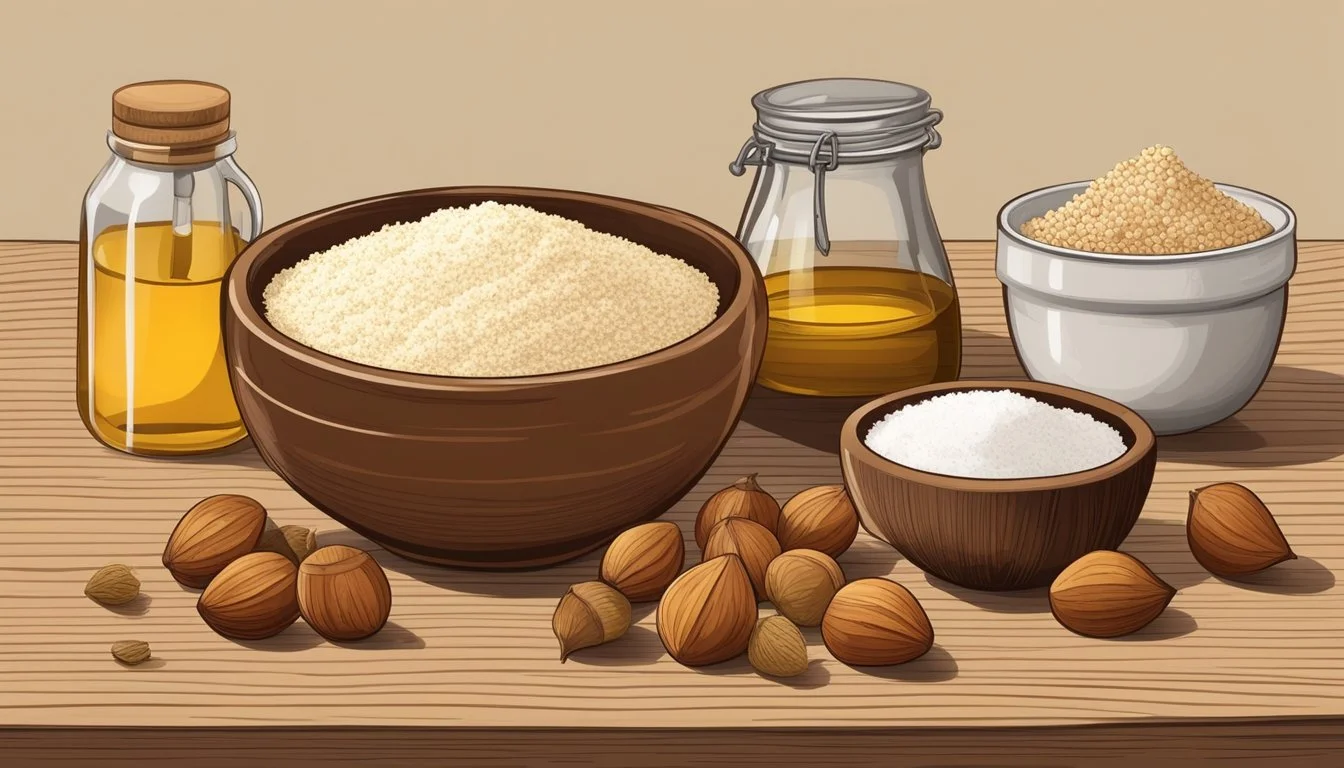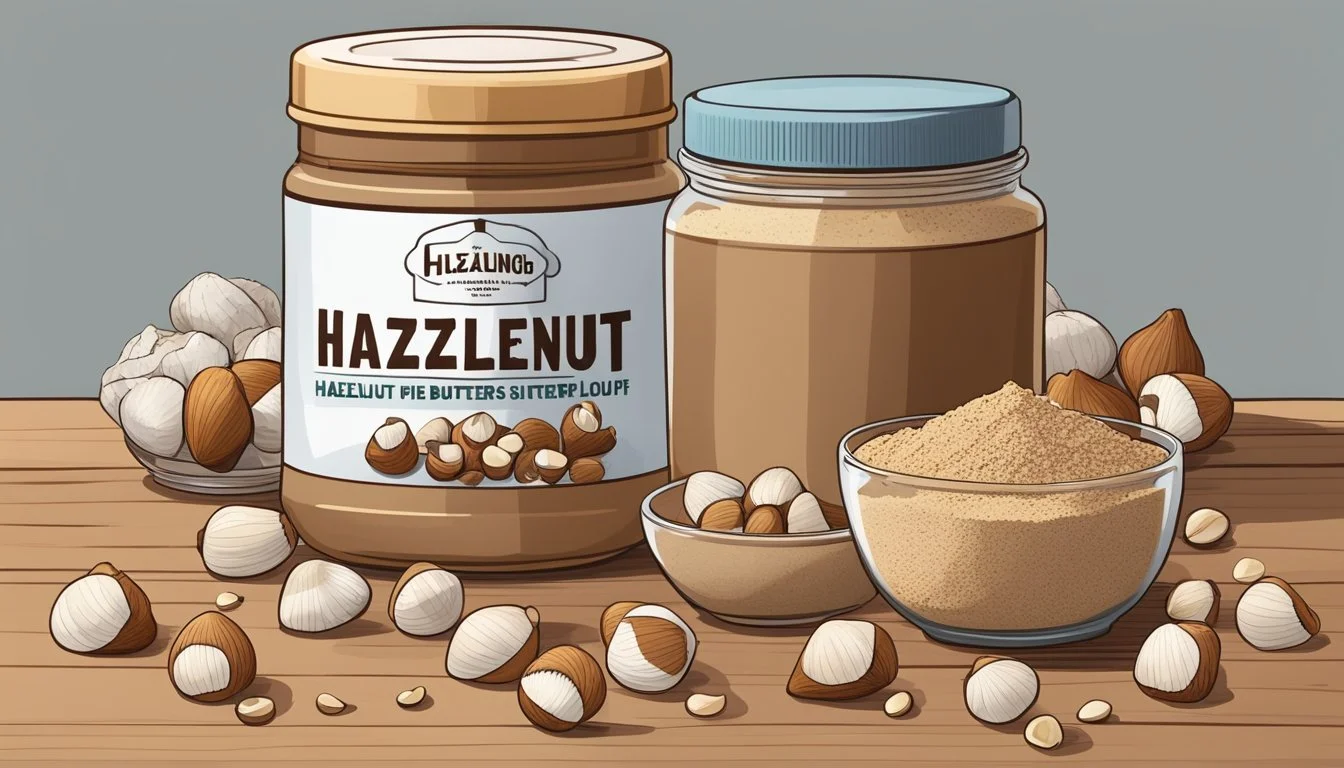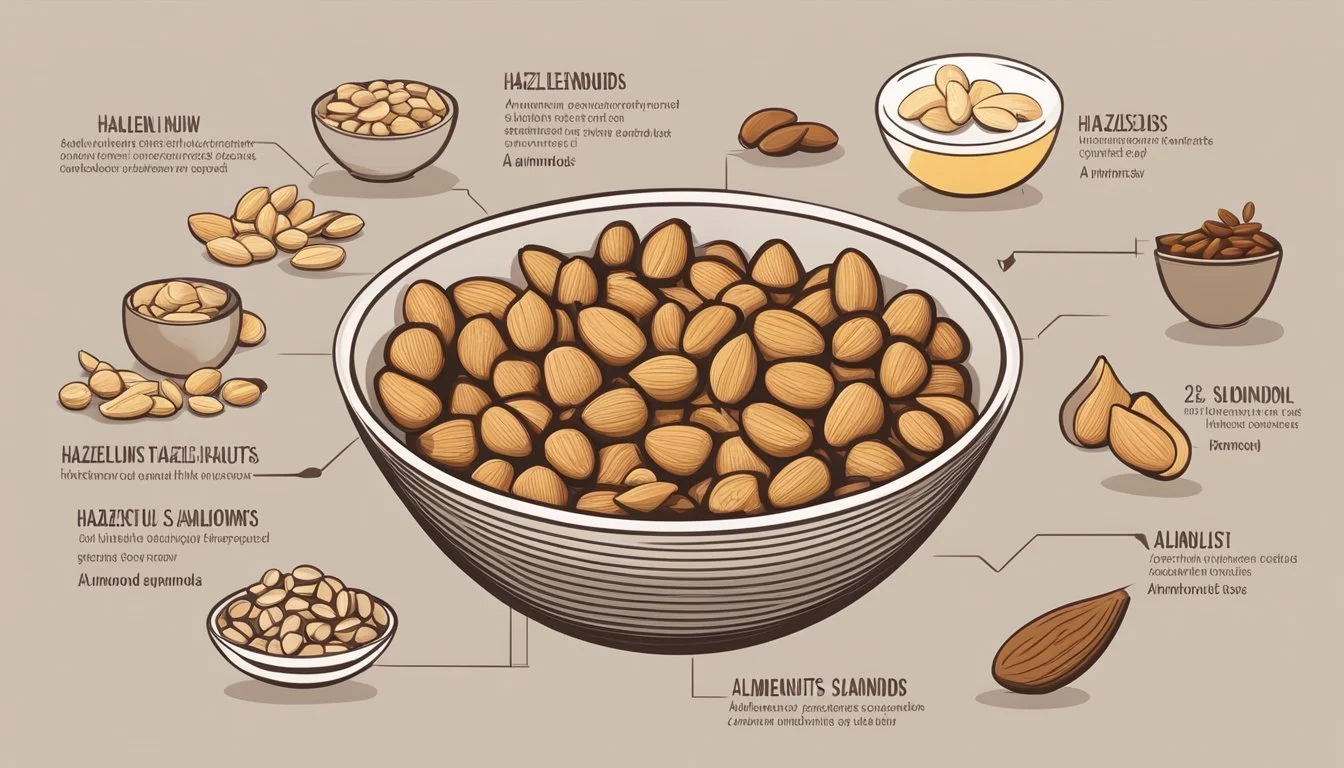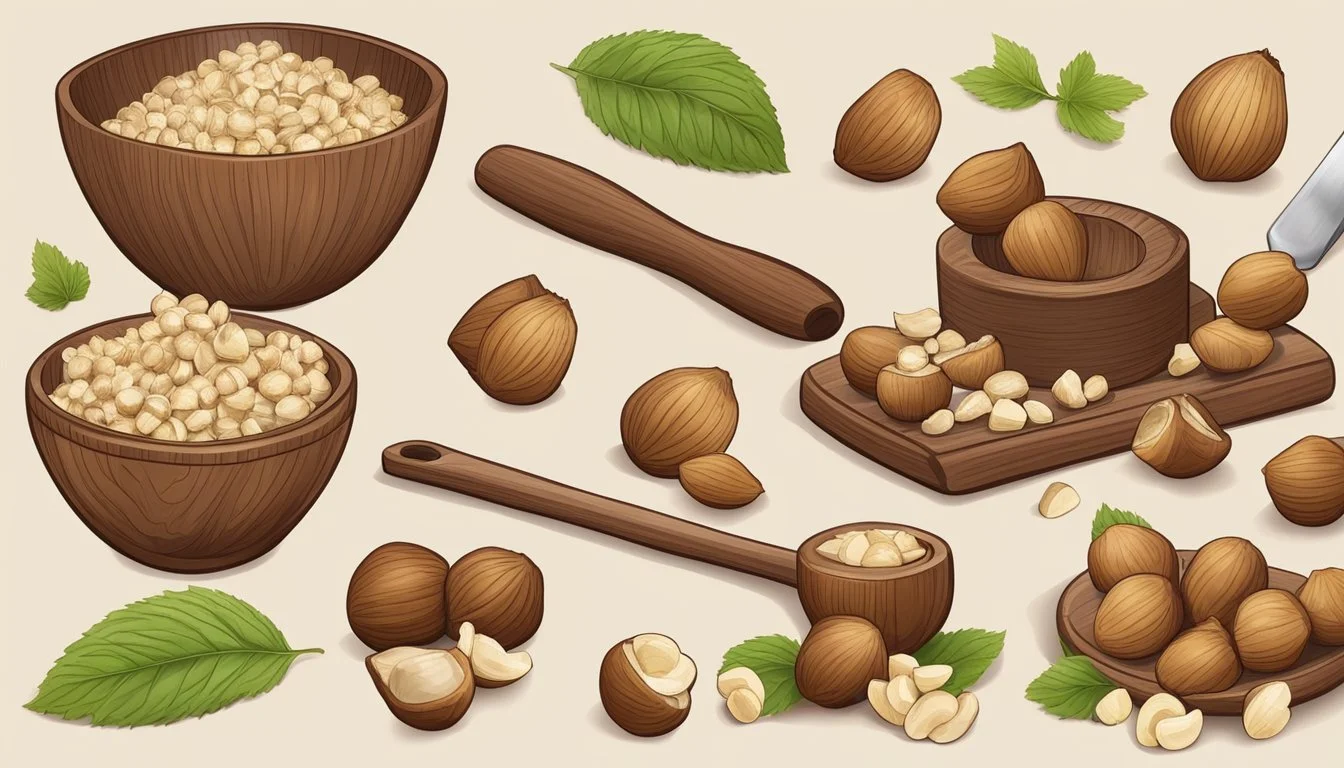Hazelnuts Substitutes
Top Alternatives for Cooking and Baking
Finding the right substitute for hazelnuts can be crucial for those allergic, unable to find them, or simply looking for an alternative flavor. Almonds serve as one of the most popular substitutes for hazelnuts due to their similar texture and slightly sweet, nutty flavor. They can easily be used in both savory dishes and sweet treats without compromising the overall taste.
Another excellent alternative is macadamia nuts, which bring a rich, buttery flavor to the table, making them a great addition to baked goods like cookies and cakes. Macadamia nuts can be used in the same quantity as hazelnuts, providing a consistent texture and taste.
For a milder flavor, cashews offer a creamy texture and work well in various recipes, including desserts like cheesecake or pudding. Cashews are versatile and can be used to enhance the richness of a dish, making them a convenient and tasty substitute for hazelnuts.
Understanding Hazelnuts
Hazelnuts, often known as filberts, come from the hazel tree. They possess a rich, nutty flavor that is both sweet and buttery. This distinct taste profile makes hazelnuts a popular choice in various culinary applications.
Flavor and Texture: These nuts offer a smooth, crunchy texture that enhances the mouthfeel of desserts and baked goods. When roasted, their flavor becomes more pronounced and aromatic.
Nutritional Profile:
Fats: Hazelnuts are rich in monounsaturated and polyunsaturated fats, which are considered healthy fats.
Protein: They provide a decent amount of protein, making them a good addition to a balanced diet.
Fiber: Hazelnuts contain dietary fiber, which aids in digestion.
Vitamins and Minerals:
Vitamin E: Important for skin health and acts as an antioxidant.
Magnesium: Essential for muscle function and overall health.
Iron: Vital for blood production.
Copper: Supports various bodily functions, including iron absorption.
Zinc: Crucial for immune function.
Hazelnuts are also packed with antioxidants, which help combat oxidative stress. The presence of these nutrients contributes to various health benefits like improving cholesterol levels and supporting heart health.
Hazelnut Oil: This oil, derived from hazelnuts, carries the same rich flavor and is often used in dressings and cooking for its nutritional benefits.
Hazelnuts are not just flavorful but also offer substantial health benefits, making them an excellent addition to various dishes.
Common Uses of Hazelnuts in Cooking
Hazelnuts are used in a variety of culinary applications, from rich desserts to savory dishes. They add a distinct nutty flavor that enhances the taste and texture of numerous recipes.
Baking and Desserts
Hazelnuts are a popular addition to many baking recipes, enhancing the flavor of cakes, muffins, and pies. Their nutty taste pairs exceptionally well with chocolate, making them a key ingredient in various chocolate-based desserts. Ground hazelnuts, or hazelnut flour, are often used in gluten-free baking.
Examples:
Chocolate Hazelnut Cake
Hazelnut Muffins
Hazelnut Tarts
They are also commonly used to make Nutella, the beloved hazelnut-chocolate spread enjoyed worldwide.
Savory Dishes and Salads
In savory cooking, hazelnuts provide a crunchy element to stuffing, sauces, and salads. Roasted hazelnuts can be sprinkled over salads for texture and flavor. They blend well with cheeses and roasted vegetables, contributing a rich, earthy taste.
Examples:
Hazelnut and Goat Cheese Salad
Herbed Hazelnut Stuffing
Hazelnut-Crusted Chicken
Hazelnuts also complement savory sauces, adding depth to dishes such as creamy pasta sauces or vegetable purees.
Nut-Based Products and Spreads
Hazelnuts are widely used to produce hazelnut butter and hazelnut oil. Hazelnut butter is a delicious spread, often used in sandwiches and smoothies. It's a good alternative to peanut butter for those with peanut allergies.
Examples:
Hazelnut Butter and Banana Sandwich
Smoothie with Hazelnut Butter
Hazelnut oil is prized for its light, nutty flavor and is often used in dressings and cold preparations to enhance dishes without overpowering them. Additionally, the oil's high smoking point makes it suitable for sautéing and roasting.
This versatile nut is an essential ingredient in numerous culinary traditions, offering a unique flavor and texture to both sweet and savory creations.
Nutritional Considerations When Substituting
Substituting hazelnuts can impact the nutritional profile of your dishes. It's crucial to address potential allergies, dietary restrictions, and the specific macro and micronutrient content of different substitutes.
Allergies and Dietary Restrictions
Many individuals have nut allergies, so it is essential to choose substitutes that do not cause adverse reactions. Alternatives such as sunflower seeds or pumpkin seeds are excellent choices for those avoiding nuts.
Gluten-free diets are another important consideration. Nuts and seeds are naturally gluten-free, making them suitable for such dietary needs.
Other options include using granola with caution, ensuring it's free from gluten and nut contaminants. Always verify the allergen information on the packaging to safeguard against accidental exposure.
Macro and Micronutrient Content
The substitution of hazelnuts will inherently alter the nutritional value of your dish. Hazelnuts are rich in healthy fats, protein, and dietary fiber. They also contain significant amounts of Vitamin E, beneficial for antioxidant properties.
Almonds, for example, have a similar nutrient profile with healthy fats, protein, and Vitamin E, making them a great substitute. Chestnuts offer a milder nutty flavor but are lower in fat and higher in carbohydrates, potentially impacting calorie content and energy levels.
Acorn flour provides a unique flavor but less protein, which might be a consideration for those looking to maintain or increase their protein intake.
Always assess the nutritional labels of substitutes to maintain the desired balance in your recipes and overall diet.
Finding the Best Hazelnut Substitutes
Substituting hazelnuts requires selecting alternatives that match their unique flavor, texture, and availability. This guide provides detailed options to ensure the best fit for your culinary needs.
For Taste and Flavor
When looking for substitutes that mimic the taste and flavor of hazelnuts, almonds and macadamia nuts are strong choices. Almonds have a similar sweetness and can be used raw or toasted to enhance their nutty flavor.
Macadamia nuts offer a creamy texture that pairs well with many dishes. For those avoiding nuts, granola provides a nutty and mildly sweet alternative, perfect for recipes like granola bars or muffins. Adding spices such as cinnamon and nutmeg can also help replicate the warmth of hazelnuts.
For Texture and Consistency
The texture of hazelnuts is often crunchy and slightly creamy. Cashews are an excellent substitute for their creamy texture while still providing a crunch, especially when roasted.
Sunflower seeds and pumpkin seeds can be ground finer to achieve a texture closer to hazelnuts and offer a pleasant crunch in baked goods.
If you need a smooth option, Nutella or hazelnut extract can provide the consistency and flavor, though these may alter the sweetness levels of your dish.
Based on Availability and Cost
Availability and cost are important factors when choosing a hazelnut substitute. Almonds are widely available in most grocery stores and are generally budget-friendly.
Sunflower seeds and pumpkin seeds are also cost-effective and can be bought in bulk. For a more budget-conscious option, granola can often be found at a lower price point and is versatile for use in multiple recipes.
Using hazelnut extract can be a cost-efficient method to impart the hazelnut flavor without the high cost of whole nuts. Select substitutes based on your region and budget to find the best match.
Throughout your culinary adventures, having a variety of hazelnut substitutes will ensure that you can adjust recipes to suit your taste, texture preferences, and budget constraints.
Types of Hazelnut Substitutes
When looking for substitutes for hazelnuts, there are several options to consider that vary based on taste, texture, and nutritional content. Key categories include different types of nuts and seeds, nut butters and flours, fruit and grain-based alternatives, and oil and fat substitutions.
Nuts and Seeds
Using nuts and seeds as hazelnut substitutes is common due to their similar texture and nutritional profile. Almonds have a comparable crunch and slightly sweet flavor, making them a versatile choice. They are readily available and can be used in both sweet and savory dishes.
Macadamia nuts offer a creamy texture and rich taste, suitable for desserts. Pecans and walnuts provide a robust flavor and are excellent in baked goods.
For those with nut allergies, sunflower seeds and pumpkin seeds are great alternatives. They can be toasted for enhanced flavor and used in a variety of recipes. Both seeds also pack a nutrient punch similar to nuts.
Nut Butters and Flours
Nut butters and nut flours make excellent substitutes for hazelnuts, especially in baking. Almond butter offers a smooth, rich texture and can replace hazelnuts in spreads or sauces. Cashew butter has a mild flavor and can be used in creamy recipes.
Almond flour is widely used in gluten-free baking and can replace ground hazelnuts in recipes. It provides a similar texture and moisture level. Cashew flour can also substitute for ground hazelnuts and works well in various baked goods, lending a mild, buttery flavor.
Fruit and Grain-Based Alternatives
Non-nut alternatives for those with allergies include fruit and grain-based substitutes. Oats can be used in recipes requiring a coarse texture. They are particularly useful in baking to provide bulk and mild flavor.
Dried fruit and fruit purees like applesauce or mashed bananas can add moisture and sweetness to recipes, though they will alter the final taste and texture. Quinoa flakes or puffed rice can also be used in some recipes, offering a light, airy consistency.
Oil and Fat Substitutions
For recipes requiring the creamy or fat content of hazelnuts, oils and fats can be effective substitutes. Hazelnut oil or walnut oil can impart a rich, nutty flavor similar to hazelnuts. Almond oil is another good option for dressings or drizzles.
Coconut oil and butter can replace the fat content provided by hazelnuts in cooking and baking. These substitutes will alter the flavor slightly but still offer the necessary richness and texture. Ghee is another buttery substitute that can provide a similar mouthfeel to recipes requiring hazelnuts.
Substitute Recommendations for Specific Recipes
When substituting hazelnuts, it's essential to consider the specific type of dish and the flavor profile you are aiming for. Different substitutes work better for baked goods, sweet dishes, and savory recipes.
Baked Goods and Confectionery
For cookies, cakes, muffins, and candy, almonds are a popular alternative. They have a similar texture and a mild flavor that blends well with other ingredients.
Pecans can also be used, offering a slightly sweeter and richer taste, perfect for adding depth to baked recipes.
Walnuts provide a more robust flavor, ideal for recipes where a stronger nutty note is desired. For a similar texture to hazelnut flour, almond flour can be a suitable option in various baked goods.
Sweet Dishes and Ice Cream
In sweet dishes like tarts, chocolates, and ice creams, macadamia nuts are an excellent substitute due to their creamy texture and buttery taste.
Cashews also work well, adding a smooth and slightly sweet flavor, perfect for creamy desserts and confections.
For a more exotic touch, pistachios can be used, adding a subtle sweetness and vibrant color, enhancing both the flavor and appearance of the dish. Brazil nuts can add a unique twist with their rich and creamy texture.
Savory Cooking and Dressings
In savory dishes such as dressings, curries, and pasta dishes, pine nuts are a suitable substitute. They have a rich, buttery flavor that enhances savory recipes.
Pumpkin seeds can add a different, yet complementary texture and taste, making them a versatile option for various recipes.
Sunflower seeds work well in dressings and sauces, offering a mild flavor that pairs nicely with other ingredients. For a nut-free option, toasted chickpeas can provide the needed crunch and mild taste in savory applications.
By carefully selecting the right substitute, you can maintain the desired texture and flavor of your dish, ensuring a successful and delicious outcome every time.
Alternative Handling and Preparation Techniques
When substituting hazelnuts, considering alternative handling and preparation techniques can significantly impact the final dish. Techniques and preparation methods can vary depending on the type of substitute used.
Nuts and Seeds
Using nuts like almonds or macadamia nuts allows for a straightforward swap. Raw almonds share a similar texture and crunch with hazelnuts, though their slightly rougher exterior may be noticeable. Macadamia nuts offer a rich and buttery flavor that integrates well in sweets.
Toasting: Enhance flavor by toasting the nuts before use.
Chopping: Chop nuts finely to mimic the texture of ground hazelnuts in baked goods.
Nut Flours
For recipes requiring a fine texture, nut flours are excellent. Almond flour and coconut flour can replace hazelnut flour in various recipes such as pie crusts and cookies.
Measurement: Use a 1:1 ratio when substituting hazelnut flour with almond or coconut flour.
Mixing: Ensure even blending to maintain consistency in batters and doughs.
Oils and Extracts
Hazelnut oil and extract provide unique flavors that can be matched with other ingredients. Sunflower oil offers a neutral base, suitable for dressings, while almond oil provides a subtle nuttiness.
Usage: Replace hazelnut oil 1:1 with sunflower or almond oil.
Extracts: Vanilla and almond extracts serve as potent flavor substitutes.
Seeds
Tolerated granola or other seed mixes can replicate the crunch and nutty flavor of hazelnuts, making them perfect for baked foods like muffins and granola bars.
Incorporation: Mix seeds well into batters to distribute evenly.
Crunch: Toast seeds first to achieve desirable crunch.
Fat Content
Consider the fat content of substitutes. Nuts and oils typically have high fat content, contributing to the moisture and texture of baked goods.
Adjustment: Reduce other fats in the recipe if using high-fat nuts.
Flavor: Ensure that the substitute's flavor harmonizes with other ingredients.
These methods enable versatile substitutions while preserving the desired culinary characteristics.
Health and Nutrition Benefits of Alternatives
Substituting hazelnuts with other nuts or seeds can offer various health and nutritional benefits without sacrificing taste or texture.
Almonds are rich in vitamin E, which supports skin and eye health. They are also high in fiber, aiding digestion, and contain proteins that help in muscle repair.
Macadamia Nuts provide a buttery flavor and are a good source of monounsaturated fats, which can support heart health. They also contain antioxidants that may reduce inflammation.
Cashews offer a creamy texture and are packed with magnesium, which is vital for bone health. They also provide essential proteins and iron, promoting energy and muscle function.
Brazil Nuts are notable for their high selenium content, which supports thyroid function and boosts the immune system. They contain healthy fats and are a source of fiber, promoting digestive health.
Sunflower Seeds are an excellent alternative that offers high vitamin E content, beneficial for skin and eye health. They are also rich in healthy fats and proteins.
Chia Seeds are great for adding to dishes due to their high fiber content, which aids in digestion. They are also rich in omega-3 fatty acids, promoting heart health and reducing inflammation.
A comparison table for quick reference:
Alternative Key Nutrients Health Benefits Almonds Vitamin E, Fiber, Proteins Skin/eye health, Digestion, Muscle repair Macadamia Nuts Monounsaturated Fats, Antioxidants Heart health, Reduced inflammation Cashews Magnesium, Proteins, Iron Bone health, Energy, Muscle function Brazil Nuts Selenium, Healthy Fats, Fiber Thyroid function, Immune system, Digestive health Sunflower Seeds Vitamin E, Proteins, Healthy Fats Skin/eye health, Overall health Chia Seeds Fiber, Omega-3 Fatty Acids Digestion, Heart health, Inflammation reduction
Substituting hazelnuts with these alternatives can maintain nutritional balance while offering unique health advantages.
Culinary Insights and Expert Tips
When substituting hazelnuts in recipes, culinary expertise offers several suggestions to ensure success. Almonds and macadamia nuts are popular choices due to their similar textures and flavors.
Ingredients:
Almonds: Slightly sweeter, suitable for baking.
Macadamia nuts: Rich, buttery flavor, perfect for cookies and cakes.
Expert Tip: Use these substitutes in equal measure to hazelnuts for balance.
Other Nut Options:
Brazil nuts: Creamy texture, ideal for desserts.
Cashews: Mild and buttery, good for both sweet and savory dishes.
Nut Oils and Extracts:
Substitute hazelnut oil with:
Sunflower oil: Neutral and light, appropriate for dressings.
Almond oil: Adds nuttiness, but check for allergies.
For hazelnut extract, consider:
Vanilla extract: Sweet and aromatic.
Almond extract: Rich in flavor, ensure no allergies.
Culinary Tips:
Consistency is key. Match the form (whole, chopped, ground) of your substitute to the original ingredient.
Toast nuts lightly to enhance their flavors before use.
Restaurant reviews and food-related recommendations often highlight these substitutes for maintaining the integrity of dishes. Product recommendations point towards organic, high-quality nuts and oils for best results.
Andrew, a food writer, emphasizes the importance of experimenting with different substitutes in various recipes to find the best match.










